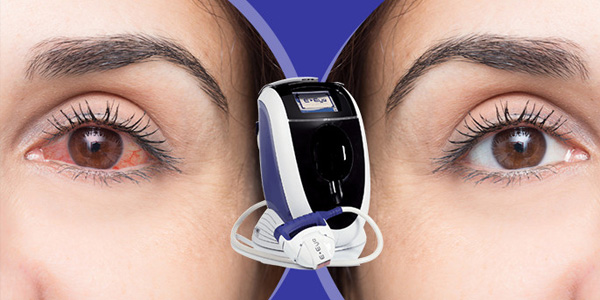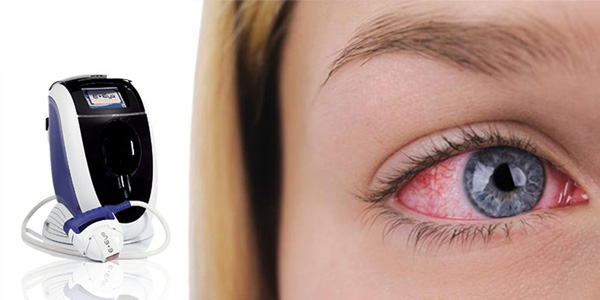About Dry Eye Disease
At Mehta Eye Clinic, we have an technological edge over treating the Dry Eye Disease (Computer Vision Syndrome) with totally painless, quick and hassle-free E-Eye Solutions.
What makes this technology stand out is the fact that it has been developed and nurtured with many years of research, testing and development. Its mechanism of action is neurological.
What is Dry Eye Disease or the Computer Disorder Syndrome?
Dry eye disease usually occurs when either the eye does not produce enough tears or when the tears evaporate too quickly. Dry eye is often also referred as Computer vision syndrome (CVS), a disorder that results from focusing the eyes frequently or for long duration on a computer or any such display device, thus disabling the eye muscles to recover from the strain.
It wouldn’t be wrong to say that India, with its large ageing and growing middle-class population along with the chronic nature of the disease, maybe on the verge of a dry eye disease epidemic.
However, it’s astonishing that the disease is heavily under-diagnosed in the nation. Being a disease that tends to progress with age, it can lead to corneal damage which can then become irreversible & cause visual impairment or even blindness. Early diagnosis and treatment is therefore of umpteen importance.
A person who is
- Undergoing the natural ageing process
- A female undergoing menopause
- Exposed to polluted environment conditions like smoke, wind and dry climate
- Using contact lens over a long period of time
- Exposed to display screens for more than 3 hours a day
- Diagnosed with meibomian gland dysfunction OR Sjögren’s syndrome OR rheumatoid arthritis
- Diagnosed with chronic conjunctivitis such as from tobacco smoke exposure or infection
- Facing infections or allergies
- Vitamin A deficient
- Recovering from recent LASIK surgery
- Under certain medications such as antihistamines, decongestants or some blood pressure medications, and antidepressants
Dry eye Disease is often coined as a symptom-based disease because, they play a key role in diagnosis. In fact in most cases, the diagnosis can be done with symptoms alone.
Visible Symptoms
- Telangiectasia – Redness
- Chalazions
- Eye Crust
- Paradoxical lacrimation
- Micro corneal ulceration
- Recurring infections
The Fleet Symptoms
- Eyestrain
- Gritty Eyes
- Pain/ Burning Sensation
- Headache
- Blurred vision
- Photophobia- feeling of discomfort in strong bright light (sun) or car headlights in the dark
- Blepharospasm – eyelid blinking with increased frequency, without bringing any relief
- Decreased visual activity – screen reading difficulties, driving by night or watching tv
- Difficulty on wearing contact lenses
- Dryness or Redness
- Watering
- Pulling sensation or pressure behind the eye
- Neck and shoulder pain
Most people may experience mild irritation with no long-term effects. However, if left untreated, it can cause complications that can lead to eye damage, resulting in to impaired vision or vision loss.
Precautions
- Control lighting and glare. Overhead lighting shouldn’t be brighter than the screen
- Maintain adequate viewing distance from monitor.
- Keep high resolution on monitor.
- Work in an upright position, avoid “turtling” of back.
- Invest in an Ergonomic chair.
- Take a break every 20 mins to stare at 20 ft away for 20 secs (20:20:20).
- Don’t wear glasses with old prescription.
- Visit an Ophthalmologist for an eye check-up.
Looking out for the symptoms:
- INTERFEROMETRY- To evaluate the quantity and the quality of the lipid component on the tear film.
- TEAR MENISCUS – The size of the tear meniscus formed on the eyelid borders provides useful information on the volume of produced tears. The tear meniscus can be examined considering its height, regularity and shape.
- NIBUT – The stability of the mucin layer and the whole tear film is measured through BUT or NITBUT, by using grids that are projected onto the cornea you are able to evaluate manually or automatically the time when the tear break up occurs.
- MEIBOGRAPHY – It images the morphology of the glands in order to diagnose any meibomian gland drop out which would lead to tear dysfunction. Meibography is the visualization of the glands through trans-illumination of the eyelid with infrared light.
- BLEPHARITIS – This test helps in detection of blepharitis and Demodex, which can be performed on the outer surface of the eye and eyelids.
- OCULAR REDNESS – Once you have captured the image of the blood vessels of the conjunctiva it will be possible to compare them to the classification sheets of bulbar and limbal redness degree.
- Pupillometry – Measurement of the pupil reaction to light with and without glare. Measurement mode: SCOTOPIC, MESOPIC, PHOTOPIC
- White to white measurement – Evaluation of corneal diameter from limbus to limbus (white-to-white distance, WTW)
- Generic Exam
Dry Eye Disease (Computer Vision Syndrome) Treatment FAQs
There are traditionally two types of treatments :
- Palliative Treatments – they don’t usually heal but simply provide relief. Their use must therefore be permanent
- Curative Treatments – they provide long lasting or definitive solution to the pathological problem. Their use and frequency depends on patient’s age & lifestyle
- Hygiene measures – Applying warm compresses to the eyelids and gently massaging them. Regularly cleansing & removing any crusts formed
- Artificial Tears (Tear Substitutes) – When lacrimal film has been altered, tear substitutes can compensate, however there’s a disadvantage that applications required everyday are frequent
- Eye Drops with active molecules – These contain antibiotics, anti-inflammatories, immunosuppressants, etc. They help tackling inflammations & infections associated with dry eye disease
- Lacrimal plugs – Small plugs are inserted into lacrimal ducts to block them, thus the tears are no longer collected and remain on corneal surface for more longer
Curative treatments strive to build a sustainable working of Meibomian glands. With these, pain will disappear very quickly and inflammatory symptoms will be regulated after a few weeks.
At Mehta Eye Clinic, we achieve these with an E-Eye device.
E-Eye is a device that deliver, very short and specific flashes of light. It’s unique features include :
- Flash
- Nervous stimulation
- Meibomian gland stimulation
- Lipid later secretion
- Lacrimal flow stabilisation
- Painless & inflammatory relief
Advantages:
- Instant improvement
- Safe & Quick procedure
- Completely painless
- Long lasting effect
- No other treatment should be applied to the zones which have received flash treatment
- Sunscreen should be applied to the zones which have received the flash treatment, incase of exposure to UV rays
- Continue with conventional ocular hygiene measures
In the short run, the treatment has 85% efficacy. The improvement will last:
- About a week after the initial treatment.
- Two to three weeks after the second.
- Between 6 months to 3 years after the third session.
Note: The effect is cumulative.
In the long run, in 60% of cases, effect persists for beyond 3 years.
In order to bring in effective results, there must be a pro-active approach from your side. You are a fifty percent partner in this journey and your role is equally important. Make sure you follow up on time and report any discomfort to your doctor for him to recommend any changes.
IDRA gives a complete Assessment of your Dry Eyes. It grades the severity of the dryness within minutes.
It includes:
- Interferometry
- Tear meniscus thickness
- Meibography


